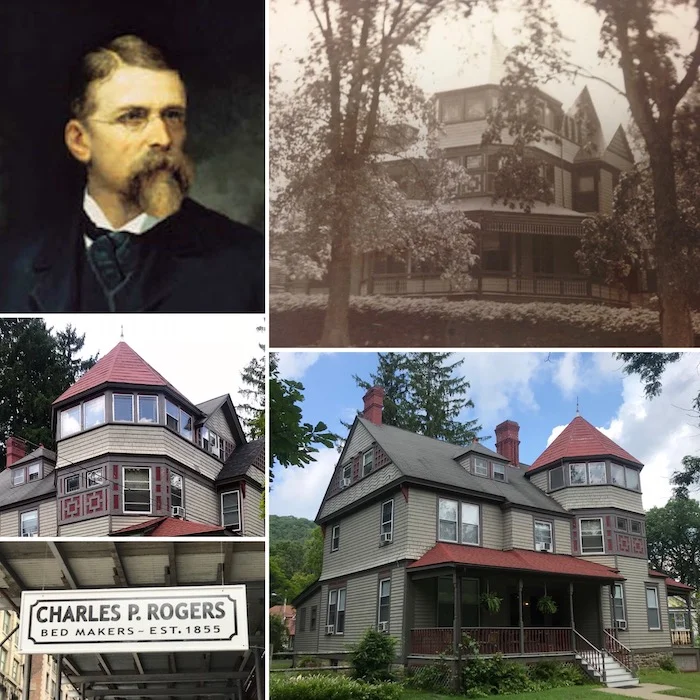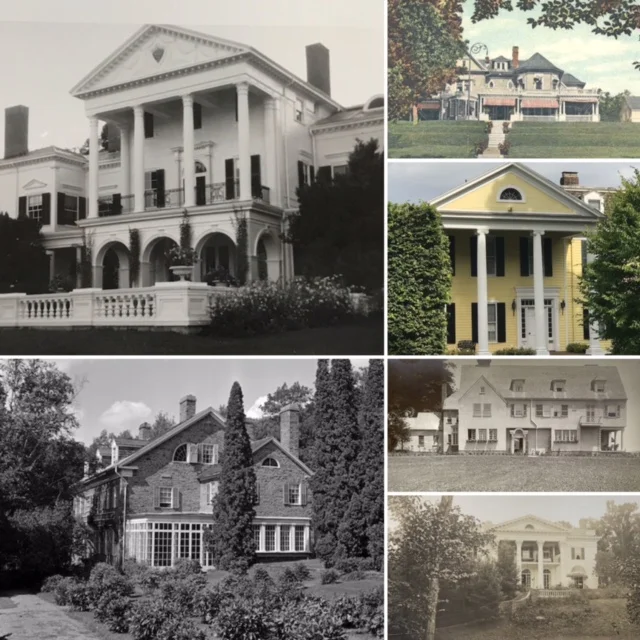The House that Bedding Bought: Cooperstown's 2 Pine Boulevard
It’s funny what can spark a connection in one’s mind. The bed we sleep came from the Charles P Rogers company less than a decade ago and I never gave it much thought .
That is, until one day earlier this year when I happened to be walking by its showroom on 17th street and noticed this sign out front.
While naturally curious about any company that has managed to stay in business for that long, something else struck a chord. My great, great, grandfather Fayette Houck had built a stable and coachman’s house in Cooperstown for a man named Charles Rogers Back in 1902. Could the two names possibly be connected? After a little digging, it turned out my hunch was correct. The two men were one in the same.
Charles P Rogers
The second son of merchant Andrew Yelverton Rogers and Jane (née Phillips) Rogers, Charles P Rogers was born in 1829 in New York City. His first recorded foray in the bedding business was in 1854 when he partnered with an established bed manufacturer named Bradford Willard (a loose association that would last for years) to produce metal cots for Manhattan’s PS 135. Within a year he had opened a retail establishment at 384 Hudson Ave, selling iron bedframes, cots and mattresses. At the same time he operated a wholesale business supplying furniture design firms such as Herter Brothers, and became the exclusive importer of Fisher Brown & Co’s fashionable brass beds manufactured in England.
Rogers decision to focus on the production and sale of metal beds was either extremely fortuitous, or extremely foresighted. As the population of New York grew at an unprecedented rate in the preceding decade, pest-borne diseases associated with crowded conditions became a great concern.
View of Broadway, 1858 photo: Getty Images
Traditional wooden beds were believed to provide hiding spots and breeding grounds for bedbugs, fleas and other associated vermin. Metal bedframes were considered to be more hygienic and easy to clean. At the same time, brass beds had become chic amongst the upper classes. It wasn’t long before Rogers had moved his business and retail operations uptown, to 264 - 266 6th Ave. at 17th Street, in the fashionable shopping district known as “Ladies Mile”.
He continued to diversify his retail and production business to encompass seemingly anything and everything bedding-related, marketing down comforters, pillows, bedsprings, divans, iron bedsteads, even custom-made yacht cushions. Thanks in part to the popularity of his brass beds amongst the city’s elite, Rogers won lucrative contracts to supply beds and bedding to Gotham’s large hotels, including the Waldorf Astoria, the St Regis, the Biltmore and the Herald Square.
Early magazine advertisements of the Charles P. Rogers Company
As his company’s reputation spread, he began supplying beds to hotels up and down the Eastern Seaboard and beyond, from the Willard Hotel in Washington DC, to the New St Charles Hotel in New Orleans. All this helped make Rogers a wealthy man.
In 1854, around the same time he was making his start in the business world, Charles married Anna Burt, who had been born in Oswego New York. Thanks in part to her upstate roots Charles began to focus his attention on that region. The family (a daughter named Minnie came along 1857) made regular visits to Oswego and frequented fashionable upstate spa towns. In 1882 The Charles P Rogers company opened its second retail location in Syracuse, New York. In 1883 their daughter Minnie married wealthy New Yorker Charles Frederic Zabriskie, whom she had first met in Richfield Springs.
Minnie Rogers Zabriskie
Charles Frederic Zabriskie
After bringing on his nephew as a partner to help run the business, Charles and Anna were able to spend more of their summers upstate, often staying at the famed Spring House Hotel in Richfield Springs. They were in residence there along with other prominent New Yorkers when the hotel was destroyed by fire in 1897.
Their daughter and son-in law had been summering in nearby Cooperstown since 1893, initially leasing Glimmerview, the former home of E F Beadle overlooking the lake formerly (they eventually purchased it from Beadle’s estate in the late 1890s for $17,500).
Glimmerview
The Rogers followed suit in 1900, leasing Crossways, a capacious cottage located just a stone’s throw from Glimmerview at 2 Pine Boulevard.
photo: Fenimore Art Museum Library, Cooperstown, NY, Florence Ward Local History Collection
Built a decade earlier, it was one of several modern cottages E F Beadle had erected in the neighborhood as he developed the area.
photo: Fenimore Art Museum Library, Cooperstown, NY, Florence Ward Local History Collection
The large wood-frame dwelling featured an asymmetrical silhouette and multi-gabled roofline typical of the Queen Anne period, with inset panels and bands of shingle siding to lend interest and variation to the exterior walls.
Its broad porch featured spindle work, reflected the influence of the Stick, or Eastlake styles, as did the handsome oak staircase, wainscoting, spindle work and cutouts inside.
A polygonal turret rose from the house’s corner on its third floor,
featuring a continuous row of windows with large single panes bordered by small lights to afford views of the lake.
Though obscured by trees today, this third floor room originally had views of the lake.
Shortly after its completion, Mrs. Robert Stewart Webb of New York City leased the cottage for a three-year period. Mrs. Webb and her husband were no strangers to Cooperstown. Née Frances Morgan, before marrying widower Robert Webb in 1883 she had been the widow of George Anson Starkweather, who came from a Cooperstown family. The eldest son of General James Watson Webb, he had his own Cooperstown connections through his mother’s family and from attending the Duffs school there as a youth in the 1840s. The Webbs had already spent several summer seasons in Cooperstown, staying at the Hotel Fenimore in 1888 and Templeton Lodge in 1889. Webb came from a large family well-known in New York’s social and business circles, most notably his younger half-brother William Seward Webb, who was married to heiress Eliza Vanderbilt. While summer colonists arriving to Cooperstown by private railroad car was not all that unusual, when William came to visit the Webbs on his own private train, the local papers took note. The Webbs purchased Crossways outright from Beadle’s estate in 1894 for the sum of $9,500.
After Webb died in 1899 at the couple’s residence in Pomfret Connecticut, his body was brought to Cooperstown for burial. Later that year, Mrs. Webb decided to put Crossways up for sale. The Rogers ended up leasing it for two summers before purchasing it outright in the fall of 1901. As the large house sat on a relatively small lot, Charles hired contractor Fayette Houck to build a carriage house with coachman’s quarters above for them on nearby Nelson Avenue soon after, completed in 1902.
The Rogers former carriage house on Nelson Avenue, later converted to a private residence
The Rogers settling easily Cooperstown’s tightly knit summer colony. They and the Zabriskies would usually arrived sometime in May (often together in a private Railway car), and often stay on into October. With the management of the company in his nephew’s capable hands, Charles could dedicate himself to his hobby of flower arranging, supplied by his daughter’s extensive gardens overlooking the lake.
photo: Fenimore Art Museum Library, Cooperstown, NY, Florence Ward Local History Collection
Back in the City, the two families also lived close to each other. Charles, ands Minnie along with their two children lived in a brownstone at 37 West 75thStreet,
while Charles and Anna were right down the street in a limestone townhouse at 145 West 75th.
Both the Zabriskie and the Rogers former homes are still standing
Anna Burt Rogers died of pneumonia in 1916, with Charles following her to the grave the following year. The Charles P Rogers Bedding Company was re-organized soon after, with their daughter Minnie (widowed herself in 1914) taking a leading role in management. 2 Pine Boulevard was leased and eventually sold, owned by several doctors before eventually being converted into apartments decades later. While portions of its porch were removed, its second floor balcony enclosed, and other modernizations have occurred, Charles Rogers former home retains much of its original detail and character.
2 Pine Boulevard today
The same holds true for his former company, which has adapted to modern times while staying true to its roots. today it is the oldest continuously operating bedding manufacturer and retailer in the United States.
I am happy for both, which serve to remind me of the sometimes unexpected connections between the grand homes of Cooperstown and the larger world.




























